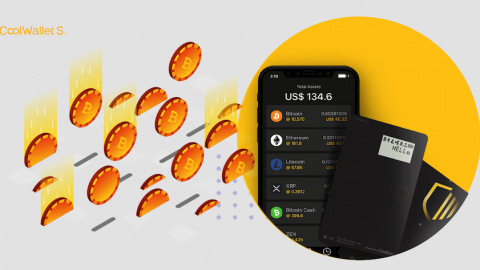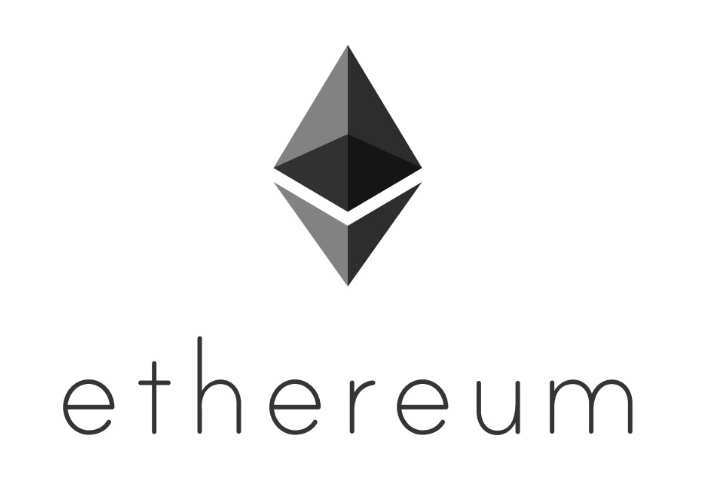
This is our behemoth Ethereum guide, first published in 2018, with the last full update done in 2021. It’s October 2023 now and a lot has happened! Since Ethereum underwent some seriously major changes in the last 2 years and made changes to its roadmap, this article is largely outdated and will be refreshed in the near future.
For the latest on Ethereum, check out our 2022 Merge guide, 2023 Shanghai upgrade which unlocked staked ETH, Account Abstraction (EIP4337) and we will soon cover the pending EIP-4844 Proto-danksharding upgrade scheduled for the end of the year. And there are also of course our layer-2 articles as well which cover a new generation of Ethereum scaling networks that will help to make it the world’s computer one day.
OK, back to business.
In this guide, we’ll cover the basics from the creation of ETH to the possible future of well-known blockchain projects. This guide is purely educational. So if you want to learn more about Ethereum and how it’s revolutionized the crypto space, read on.
Table of Contents
- What is Ethereum?
- What are Smart Contracts?
- What are Decentralized Applications (DApps)?
- Ethereum Virtual Machine (EVM)
- Ether (ETH) and Mining
- Second-Layer Solutions (Layer 2 and Off-Chain Scaling)
- What is Ethereum 2.0?
- Beacon Chain
- Ethereum Staking
- Running an Ethereum Full Node
- Staking Via Ethereum Pools
- Shard Chains
- Ethereum WebAssembly (eWASM)
- History of Ethereum
- DAO Attack
- Hard Fork- Ethereum splits into ETH and Classic (ETH)
- 2019 Hard Fork -Constantinople and Petersburg
- Ethereum Price History- All-Time High and the 2021 Bull Run
- London Hard Fork
- Ethereum vs. Bitcoin: What’s the Difference?
- Founders
- Ether vs. Bitcoin
- Supply
- Transaction fees
- Mining
- Block Times
- Advantages and Disadvantages of Ethereum
- Ethereum Common Use Cases
- Centralized vs. Decentralized Apps
- ERC20 Tokens
- Who are Ethereum’s Competitors?
- Binance Smart Chain
- Solana
- Polkadot
- Ethereum Classic (ETC)
- Cardano (ADA)
- How to Buy ETH
- How Do I Store Ethereum?
- Hardware Wallets
- Paper Wallets
- Desktop and Online Wallets
- Additional Ethereum Resources
Introduction
Ethereum is currently firmly established as the second biggest digital asset after Bitcoin, in terms of market capitalization, with the latter dominating the crypto universe (over $866 billion market cap). As of August 2021, Ethereum is in second place, with a market share of over $372 billion, over $300 billion more than its next competitor, Binance Coin (BNB).
But Ethereum’s worth must be measured in more than US dollars. It is a revolutionary virtual asset network that has changed the way we view cryptocurrencies and what they can do in terms of innovations like “smart contracts”, which has undoubtedly proven that blockchain’s use cases extend far beyond payments.
For years, technologies like decentralized finance (DeFi) and non-fungible tokens (NFTs) were merely idealistic concepts. Today, you can see them in action through Ethereum-based decentralized platforms like the Uniswap exchange, Aave lending network, and OpenSea digital art marketplace, among many others. These technologies have brought a paradigm shift to the way platforms work, where rules are equally decided and enforced by everybody and middlemen or overseers are no longer necessary.
Moreover, the rise of boatloads of Ethereum play-to-earn games like Axie Infinity, My Crypto Heroes, ChainGuardians, etc. have not only entertained, but also empowered people to earn a livable income despite losing their jobs in the pandemic.
One could even argue that Ethereum has brought blockchain technology further than Bitcoin ever could, seeing as most of the innovations of the industry either came from Ethereum’s development or are built using its toolsets.
Despite the rise of competitor smart contract blockchains Polkadot, Binance Smart Chain, and Solana, Ethereum’s market share is still three times larger than all of them combined.
However, there is a major traffic bottleneck that makes transactions costly, which is exacerbated by Ethereum’s all-too-familiar upgrade delays, but at least we now have a working global computing network that allows anyone to build unstoppable programs on top of it. Not too many people understand the power that everybody now has access to thanks to this smart contract platform.
Then there’s the London Fork upgrade, which has made Ethereum more scarce due to a new mining scheme that burns transaction fees, which could possibly make Ethereum deflationary in the future.
1. What is Ethereum?
Ethereum is an open-source, public, decentralized computing platform and operating system that exists on a blockchain that supports smart contract functionality, and the deployment of decentralized applications (DApps). Since its inception Ethereum has developed into an ecosystem and birthing place for most of the crypto industry’s most innovative new fields and use cases, which includes decentralized finance (DeFi) and non-fungible tokens (NFTs).
Its native digital asset Ether (ETH) is the world’s second biggest cryptocurrency by market cap and was created by former Bitcoin Magazine co-founder, Vitalik Buterin, and British programmer, Gavin Wood, in 2013, and ultimately released in July, 2015. It has 8 listed co-founders, including Charles Hoskinson, Cardano’s frontman.
If the description of Ethereum above does not ring any bells, another popular comparison is to that of a Turing-complete “world computer” that is open source, allowing anyone to run unstoppable applications on top of it. But, you might wonder, why does the world need such a system? Most of us already have our own PCs and mobile computers at home.
Let’s explore a real-world scenario:
John is an equal rights activist in the US who wants to exercise his right to free speech online. Unfortunately, he dreads the possibility of losing his Facebook and Twitter accounts due to the nature and sensitivity of the topics he discusses.
Social media platforms have nearly absolute control over user accounts and can police them as they see fit. John realized that his work is far too important to be at the mercy of these giant tech corporations that could ban his account at any time and erase everything he’s built.
He then decides to sign up to a new Ethereum-based social media platform, Sapien, and starts creating content there as well. When the day comes that Facebook and Twitter restrict his accounts or ban him completely, he already has a backup platform that’s unstoppable. Problem solved!
Ethereum can not only allow you to circumvent restrictions from corporations but also from authoritarian governments. This makes it an extremely valuable tool not only for building sophisticated applications but for attaining personal freedom as well.
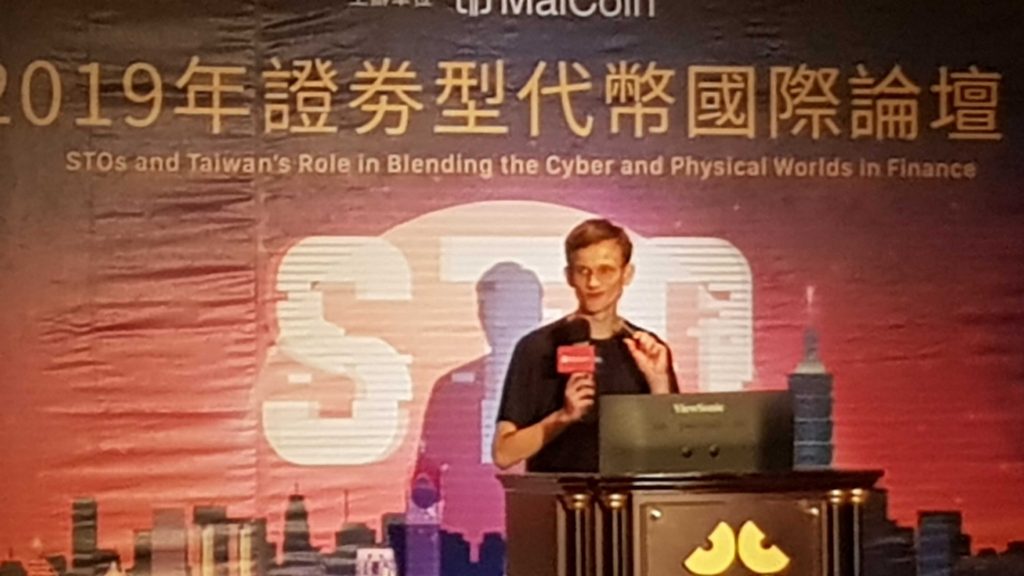
Vitalik Buterin 2019 Taipei Ethereum conference
What are ERC-20 Tokens?
As we’ve been touching on this entire piece, the crux of Ethereum’s power and appeal is in its creation, powering, and diversity of smart contracts on the Ethereum network.
So, what happens when developers want to launch a project and token on the Ethereum network?
You get an Ethereum Request for Comment, also known as an ERC-20 token.
ERC-20 is an Ethereum token technical standard guiding smart contracts and their functionality in the Ethereum ecosystem. The ERC-20 standard exists to ensure predictability in performance and security amongst projects on the Ethereum blockchain. After all, given the vast number of applications built on the blockchain, it’s important for stability purposes to have some sort of uniformity. Simply put, ERC-20 exists so new applications and projects can work coherently with existing projects on the Ethereum platform.
After a terrible 2018, in which over $1.7 billion USD was stolen or scammed from crypto investors, many analysts blamed Ethereum’s easy ERC-20 token start-up capability as a breeding ground for ICO scams that were meant to rob the public blind or act as money laundering and terrorism funding vehicles.
In January, 2018, there were more than 21,000 ERC-20 token contracts on the Ethereum blockchain, including notable projects such as EOS, Qash, OmiseGO, Basic Attention Token, and more.
By the beginning of 2021 , there were 829 ERC-20 token projects and over 350,000 token contracts, according to Etherscan. In September 2021, it stood at over 450,000 token contracts!
Check out this comprehensive list on Etherscan.
CoolWallet Storage Tip: Steer clear of saving any exchange, wallet, or other cryptocurrency passwords online. Instead, write down your pin and recovery seed on a piece of paper, make copies, and store them safely in your home or at a bank.
What are Smart Contracts?
Broken down further, Ethereum’s smart contracts can be thought of as a vending machine, where instead of seeking out a lawyer, notary, or transcriptionist, users spend their cryptocurrency (tokens) in exchange for a drafted contract, escrowed transaction, or other transactional function.
Based on different computer languages, Solidity, Serpent, LLL, Mutan, etc., smart contracts are all-encompassing computer protocols, not only defining the parameters and penalties governing transactions, but automatically enforcing them as well, ultimately, eliminating “downtime, censorship, fraud or third-party interference.”
Ethereum’s smart contracts are developed through programming languages Solidity and Vyper, but the forthcoming Ethereum WebAssembly (eWASM) will allow developers to build Ethereum smart contracts using traditional languages like C++, Rust, and Javascript, etc.
What are Decentralized Applications (DApps)?
Commonly referred to as DApps, decentralized applications are based on the Ethereum platform and its smart contracts, running on a peer-to-peer network and boasting four key characteristics:
- Open-source and autonomously controlled,
- Use of the blockchain to store data,
- Use of a cryptographic token to store value, and
- Generation of such a token through a cryptographic algorithm.
What separates decentralized applications from standard applications is the infrastructure of their back-end servers, omitting the use of programming languages such as Rails or Django in favor of blockchain technology – removing centralized hosting services and putting power and autonomy back in the hands of its users.
As of October 2023, there are tens of thousands of DApps on the Ethereum blockchain, including, but not limited to, DApps for:
- Games,
- Collectibles platforms,
- Digital signatures,
- Smart locks,
- Digital proprietary rights management for copyrighted works,
- Prediction markets,
- Crowdfunding platforms,
- Remittance,
- Online casinos and gambling,
- Electric and clean energy car charging,
- Secure identity systems, such as KYC controls.
Ethereum Virtual Machine (EVM)
Fueling Ethereum’s security and code execution is the Ethereum Virtual Machine (“EVM”) – the protocol handling computation and its internal state.
The EVM is a key innovation separating Ethereum from its narrowly functioning big brother, Bitcoin, which was constructed with one function in mind – to act as a currency.
The EVM however, was designed to act as a runtime environment for smart contracts based on Ethereum, allowing any user or developer to create applications via the Solidity language, while ultimately,
- Automating transactional processes,
- Performing specific actions,
- Preventing Denial-of-service (DoS) attacks, and
- Ensuring uninterrupted communication across the network.
The EVM’s distribution of computing across the network “gives Ethereum extreme levels of fault tolerance, ensures zero downtime, and makes data stored on the blockchain forever unchangeable and censorship-resistant”.
In simple terms, the EVM could be viewed as one giant environment conducive for building bigger, better, and more powerful smart contracts. Instead of the creation of an original blockchain for each new project, the EVM allows applications and users to build in one place on top of previously laid foundations.
Unfortunately, it has some real-world limitations, which is why the Ethereum Foundation is working on its successor, the Ethereum WebAssembly (eWASM), which is set for release sometime in 2022.
Ether (ETH) and Mining
When understanding Ethereum, it’s important to differentiate between the Ethereum blockchain and the fundamental cryptocurrency for its operation – Ether, abbreviated to ‘ETH’.
Ether is not the technology, but the token which pays computational costs – also known as gas – and transactional fees. It’s the fuel that keeps the car running.
Any time a user wants to execute a smart contract or send Ether to another user on the network, there needs to be confirmation and recordation of this – the task is not executed by a centralized server or company per se, but by thousands (and growing) of computers around the world – this consensus model is known as Proof-of-Work (PoW).
As a reward for validating and processing transactions via PoW – also known as mining – users – commonly referred to as miners – are rewarded in Ether (ETH), as their computational resources have not only solved a complex algorithmic problem, but contributed towards maintaining the security, integrity, and validity of the network.
In simple terms, the more complex and sophisticated the computational commands you want to execute, the more gas (Ether) you will be required to pay.
Once again, it’s important to understand that when purchasing Ethereum, you aren’t actually purchasing “Ethereum”, you’re purchasing “Ether” – the token powering transactions across the network.
Unfortunately, ETH mining was never meant to last as long as it has as Vitalik had proposed Ethereum’s transition away from PoW to Proof-of-Stake (PoS) due to PoW’s consumption of exorbitant amounts of energy and resources, as well as its lack of base-layer scaling solutions.
Ethereum has a similar dynamic mining difficulty scheme to Bitcoin since both blockchains use PoW. But unlike Bitcoin’s difficulty that only adjusts according to the mining power in the network, Ethereum’s mining difficulty is programmed to increase until it ultimately becomes unprofitable, which would force miners to shift to staking, making mining obsolete.
However, a new implementation dubbed as the “difficulty time bomb delay” was recently rolled out to amend the mining difficulty increase, which would allow mining to go on at least until the merge of Ethereum 1.x and 2.0 in 2022.
Second-Layer Solutions (Layer 2 and Off-Chain Scaling)
Layer 2 (L2) is a concept that describes various solutions aimed at scaling a blockchain’s capacity by handling transactions off the mainnet (layer 1), while still utilizing its decentralized security system. With the rising popularity of Ethereum, its current layer 1 is becoming a bottleneck, causing transaction delays and rising fees. A slew of new layer-2 chains like optimistic and ZK rollups such as Arbitrum, Optimism, Linea and zkSync have helped to alleviate these issues in the interim before Ethereum 2.0 is fully launched, but it’s not the be-all-and-end-all solution for scaling.
There are a couple of second-layer solutions that are already functional, such as Optimism, which recently deployed its bridge to the Ethereum network. Another L2 solution that is thriving is Polygon, an inter-blockchain scaling protocol that has its own native currency called MATIC, which boasts over 400 projects built on top of it, including The Graph, Poly Network, Terra Virtua, and many more.
2. What is Ethereum 2.0?
Ethereum 2.0, also known as Eth2 or Serenity, is a major upgrade to the Ethereum blockchain network. It aims to improve scalability, security, and sustainability, addressing some of the limitations of the current Ethereum network.
The main feature of Ethereum 2.0 is the introduction of a new consensus mechanism called Proof of Stake (PoS), replacing the current Proof of Work (PoW) system. PoS allows participants to become validators by locking up a certain amount of Ether (ETH) as collateral, which they can stake to propose and validate new blocks. This change reduces energy consumption and increases transaction throughput.
Another key aspect of Ethereum 2.0 is the introduction of shard chains. Currently, the Ethereum network operates as a single chain, processing all transactions and smart contracts. With shard chains, the network will be divided into smaller chains, or shards, each capable of processing its own transactions and smart contracts. This enhances scalability by allowing multiple transactions to be processed simultaneously.
Ethereum 2.0 will also introduce other improvements such as eWASM (Ethereum WebAssembly), which will enhance smart contract execution speed and flexibility, and crosslinks to improve communication between shard chains and the main Ethereum chain.
The transition to Ethereum 2.0 is being rolled out in multiple phases. Phase 0, the Beacon Chain, was launched in December 2020, which introduced the PoS consensus mechanism. Phase 1 is expected to introduce shard chains (starting with Q4 2023’s foundation-laying EIP-4844 Proto-danksharding upgrade), while Phase 2 will focus on enabling smart contracts on the shard chains.
Overall, Ethereum 2.0 is expected to significantly enhance the scalability and efficiency of the Ethereum network, enabling it to handle a larger number of transactions and applications while reducing energy consumption.
Beacon Chain (December 2020)
The Beacon Chain, the foundational layer for a more scalable and sustainable Ethereum, is already live on the mainnet, running alongside Ethereum 1.x in a dual PoW-PoS consensus mechanism. The new Ethereum chain is designed to be substantially more efficient and less energy-extensive than PoW, allowing nodes to run even with older-generation computers like the Intel i5-760, thanks to the superior flexibility of its PoS design.
The Beacon Chain’s main function is to keep track of validators and manage the Shard Chains, the upcoming scaling mechanism. You could think of it as the glue that holds the new system (Ethereum 2.0) together.
Ethereum Merge (April 2023): The Move To Proof of Stake
The Ethereum Merge marked a pivotal shift in Ethereum’s blockchain, merging its original Mainnet with the new Beacon Chain. This transition moved Ethereum from a mining-based proof-of-work (PoW) model to a more energy-efficient proof-of-stake (PoS) model.
From Proof-of-Work to Proof-of-Stake
Previously, Ethereum relied on miners to validate transactions and create new blocks—a process known for its high energy consumption. The Merge replaced this with a PoS model, where validators, chosen based on their held and staked coins, take up the role of transaction validation and block creation, significantly reducing energy usage.
The planning for the Ethereum Merge began as far back as 2017, making it a well-anticipated upgrade aimed at addressing scalability and energy efficiency issues inherent in the PoW model.
Eco-Friendly Outcomes
With the Merge, Ethereum slashed its energy consumption and carbon footprint by an impressive 99.99%, stepping towards a more environmentally friendly operation. This move also sets a sustainable precedent within the blockchain space.
The Ethereum Merge paves the way for further scalability enhancements, making Ethereum faster and more adaptable to growing user demands. This transition not only marks the end of the energy-intensive PoW era but also ushers in a new phase of eco-friendly and efficient blockchain operations, reinforcing Ethereum’s innovative standing in the blockchain community.
Ethereum Staking
Shortly after the launch of the Beacon Chain, Ethereum staking became readily available for the public. With PoS, instead of miners validating transactions via the solving of mathematical problems, transactions are validated by “stakers”, “forgers”, or “validators”, who place their coins and tokens in a specialized wallet to validate transactions, and are determined by their wealth or stake in the network.
Validators are rewarded based on the number of ETH they stake to incentivize the community to participate. Staking is crucial for the operation of the Ethereum network, especially after mining becomes obsolete. Ultimately, PoS serves as a far greener and cheaper consensus mechanism than PoW, making it practical for Ethereum’s mass adoption.
Perhaps you are entertaining the thought of becoming an Ethereum validator yourself. Before you begin your ETH 2.0 staking journey, there are a few factors and risks you need to take into account.
- Staking your ETH is no long-term commitment. Thanks to April’s Shanghai upgrade,ETH stakers can now unstake whenever they wish.
- Your validator node needs to be consistently online to receive full rewards.
- Cheat and you get slashed. Any attempt to cheat the system or act against the benefit of the network gets punished through slashing, where you get penalized with a fee. Note that the minimum amount for slashing is 1 ETH. You’d be wise to consistently be on your best behavior while staking.
- There might be bugs. Ethereum 2.0 is still an early-stage project, hence, it is bound to have bugs. As an early contributor and benefactor, you pay the price of possibly encountering bugs that could result in slashing, albeit unlikely.
If you’re still interested in staking even after learning all that then by all means do so. There are two ways to stake ETH 2.0, either by:
- Running a full node yourself (if you have a lot of spare cash)
- Joining a staking pool
Running an Ethereum Full Node
If you can afford to, running a full Ethereum node is the recommended method of staking as it enables you to privately and trustlessly participate in the network’s operation while increasing its decentralization level. The more independent nodes, the more decentralized Ethereum gets.
Ethereum staking is far less demanding than Bitcoin mining when it comes to equipment costs. However, the 32 ETH minimum requirement of running a full node would cost slightly above $100K in today’s prices, which is beyond what an average person could afford.
Here are the requirements to run an Ethereum full node and stake:
- At least 32 ETH
- The mainnet software client
- A modest computing device
- Around 500GB of SSD storage
- A stable 24/7 uncapped internet connection of at least 900MB/hour, and is likely to increase.
If you opt to run a full node, you’ll need to set it up, which could be a hassle, especially for non-technical users. It is important for you to take your time and follow the instructions well to avoid making costly mistakes. Also, be sure that you’re ready for the commitment required, since you won’t be able to retrieve your funds possibly for more than a year.
If you’re one of the lucky few who have the budget for staking ETH via a full node, head over to the Eth2 Launchpad and follow the instructions to be part of the growing Ethereum staking community.
Staking Via Ethereum Pools
If you don’t have 32 ETH, there’s still a way for you to become a staker with what little ETH you have by joining a pool. In fact, if you do stake this way, you’ll be free of the burden of setting up and managing a full node. Most staking companies will do all that for you.
However, nothing is free, so you will likely be charged a fee for the maintenance of the validator node, which could eat up a portion of your earnings.
Note that outsourcing your validator node means you won’t have full control over the validator node let alone have access to the private keys.
Staking pools are valuable in their own way as they enable individuals of average income to participate in the staking community. Unfortunately, having too many stakers in pools over individual node runners could harm the network’s decentralization. But if you have no choice, there are tons of staking services for you to participate in, including Binance and Coinbase.
Shard Chains
Sharding is the holy grail of Ethereum scaling, which would allow the network to go from roughly 15 transactions per second (tps) to over 100,000 tps, far surpassing Visa’s theoretical 50,000 tps. If fulfilled, it would be the answer to all Ethereum users’ prayers as all manner of ETH transactions from sending payments to yield farming, to liquidity mining, to minting NFTs, to taking out loans would become drastically cheaper than they are today.
Sharding is the process of splitting the Ethereum network into partitions known as shards, which would eliminate network congestion and increase transaction capacity and speed. The Ethereum network will be split into 64 partitions that run in parallel and interoperate smoothly.
The implementation of Shard Chains is slated for Summer 2022, however, they won’t be fully functional for a while so don’t expect 100k tps right after launch. But, they should be able to provide phenomenal transaction speed and capacity improvements when combined with second-layer scaling solutions by then.
Ethereum WebAssembly (eWASM)
The Ethereum WebAssembly (eWASM) is a new-and-improved virtual machine that offers several key advantages over the current EVM model.
- It adds support for common programming languages like C++, Go, Rust, etc., which eliminates the need for Solidity to build smart contracts and opens up Ethereum to the 26.9 million non-blockchain developers worldwide.
- It improves Ethereum’s runtime environments, allowing it to run on modern browsers.
- eWASM is an ultra-high performance system thanks to its high-adaptability to any machine-level code design.
- It is compatible with most modern hardware design.
- It executes as fast as most centralized platforms.
The original EVM prioritizes correctness over efficiency, which many developers believe to be unsuitable for real-world conditions. The eWASM upgrade, on the other hand, favors efficiency and speed, and is built for running real-world applications.
3. History of Ethereum
In late 2013, a then 19 year-old Vitalik Buterin published the Ethereum whitepaper, addressing Bitcoin’s need for a scripting language for app development.

Buterin ultimately proposed a revolutionary platform with a “more general scripting language” that allows anyone to build programs such as smart contracts, financial agreements, personal identity registries, and much more.
The idea wasn’t well received at first, but soon gained traction in the following year.
In 2014 came the Ethereum Foundation (Stiftung Ethereum), a nonprofit foundation created to promote and support the Ethereum platform, shortly followed by an initial coin offering (ICO), and development of core technology.
Subsequently, excitement began to build as the technology began to solidify, and developers flocked to the platform – Ethereum was progressing rapidly.
DAO Attack
All was smooth, until one event in 2016 threatened the very existence and future of the Ethereum project – The DAO Attack.

Short for the ‘decentralized autonomous organization’, The DAO was a set of smart contracts developed on the Ethereum platform, raising a historic US $150 million in crowdsale funding.
In order to influence development of the project, investors were required to purchase DAO tokens with ether, also known as ETH (the fundamental cryptocurrency fueling Ethereum’s operation).
Not long after close of the crowdsale, The DAO was exploited – resulting in over USD $50 million in ether being drained from DAO funds, and leaving the Ethereum community wondering whether to perform a divisive “hard fork” in order to reappropriate the lost funds.
Hard Fork- Ethereum splits into ETH and Classic (ETH)
Ultimately, the network hard-forked, and split into two, giving us what we now know as Ethereum (ETH) and Ethereum Classic (ETC) – and thus, bringing us into the present day.
To read up further on The DAO Attack, and Ethereum’s successive hard fork, check out this comprehensive timeline and article here.
This post addresses the former (ETH), and will only briefly touch on Ethereum Classic and its core differences to Ethereum.
CoolWallet Storage Tip: If you’re holding more than one month’s salary in cryptocurrency on an exchange, we strongly encourage you to move it to cold storage. A small investment in security now, will pay dividends in the future. To read up more on cold storage, check out ‘Section 7: How Do I Store Ethereum?’
2019 Hard Fork -Constantinople and Petersburg
In January 2019, Ethereum was set to be undergo another hard fork to delay the “difficulty bomb” and pave the way towards an eventual Proof-of-Stake transition. With only hours to go, an external security team discovered a major vulnerability that one of the Ethereum Improvement Protocols (EIP), EIP1283 would bring to Ethereum. The hard fork was postponed till February and bundled with another hard fork to undo EIP1283. The late discovery of the security threat and subsequent public resignation of senior Ethereum team members caused signficant strife within the Ethereum community.
In late February 2019, both hard forks, or network upgrades, finally got implemented. The first upgrade, Constantinople, deployed all 5 Ethereum Implementation Protocols (EIP), including EIP1283, in order to smooth Ethereum’s journey to Proof-of-Stake and delay the difficulty bomb.
Petersburg was then activated immediately after and replaced Constantinople. It removed EIP1283 and thereby fixed the re-entry vulnerability that caused the hard’s fork delay in January.
You can read our guide to Ethereum’s 2019 hard forks here.
Ethereum Price History- Bull run’s All-Time High and the “Flippening”
In late 2017, Ethereum’s price surged in tandem with Bitcoin. The price of ETH reached an incredible $1431 price in January 2018, during a speculative frenzy in anticipation of the so-called “Flippening”, which is the future moment that Bitcoin’s market cap will be eclipsed by another cryptocurrency.
The flippening never happened, and as Bitcoin’s price fell in 2018, so did Ether’s, even faster, dropping at one stage to around $80. ETH made a comeback in 2019 with Bitcoin’s bull run, but many longtime HODL’ers were severely disappointed by the lack of a price pump that never materialised. Still, some Ethereum holders are still confident. You can track the “Flippening” here!
In early to mid 2020, Ethereum’s price surged in tandem with Bitcoin, making them the two largest cryptocurrencies leading the crypto market bull run. Being the blockchain platform of choice for Dapp developers, the price of ETH reached a whopping $4,196 in May 2021, surging even faster than Bitcoin during the speculative frenzy of DeFi and NFTs.
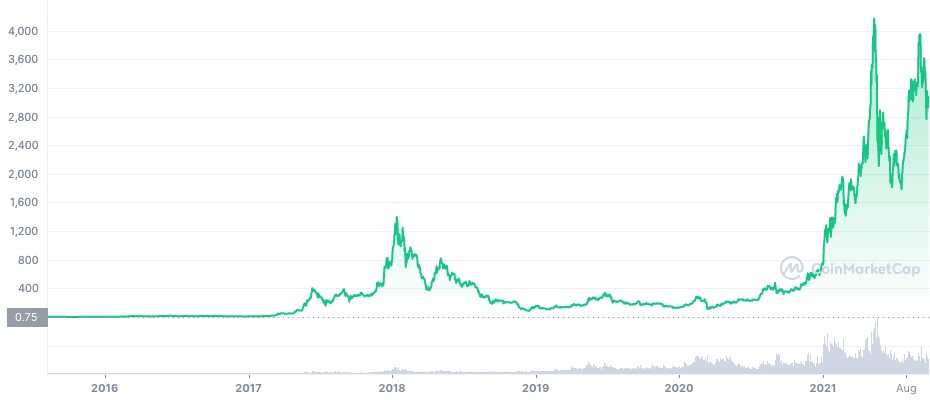
The growing popularity of Ethereum, as well as alternative platforms like Binance Smart Chain, Solana, and Polkadot, has vastly contributed to the proliferation of thousands of DeFi, NFT, and crypto gaming applications.
Following the Elon and China FUD, the space suffered a 3-month slump, with ETH dropping to less than half of its all-time high value, but, in August the market started to pick up the pace and steadily went back to its original upward trajectory.
London Hard Fork
The London Hard Fork, which was successfully launched on August 5, 2021, introduced two major improvements to the Ethereum protocol. The EIP (Ethereum Improvement Proposal) 1559 is an upgrade aimed to partially alleviate Ethereum’s exorbitant gas fees and network congestion.
Instead of the previous auction-style transaction scheme where the highest bidders get their transactions settled first, the implementation introduces a fixed-price for the fees according to the congestion level of the network. Furthermore, the base fees paid by spenders will be burned instead of being used as additional rewards, making ETH more scarce, and in turn, deflationary. In fact, the coin’s value continues to rise in a series of short surges following the implementation.
The London Hard Fork also included a mining difficulty delay, which amended Ethereum’s increasing difficulty to allow miners to continue their work until the forthcoming merge in 2022.
4. Ethereum vs. Bitcoin: What’s the Difference?
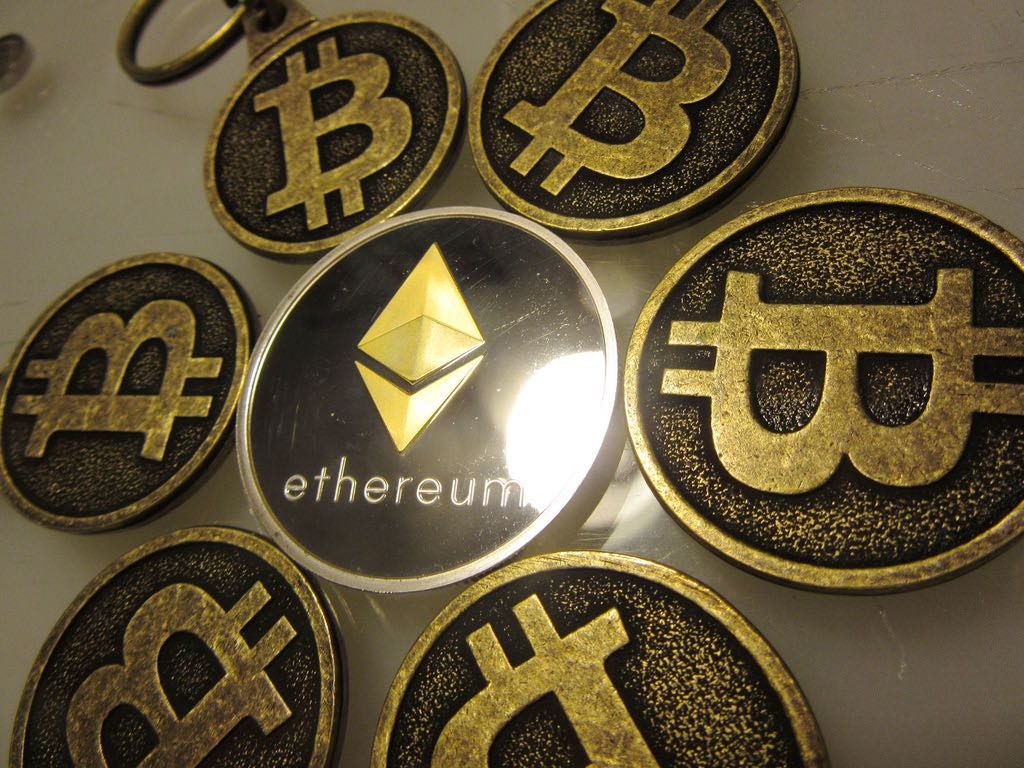
Although striving to repair and fill different gaps and issues in present day society (and the economy), Ethereum and Bitcoin oftentimes can’t help but be mentioned in the same sentence by cryptocurrency enthusiasts and investors due to their decentralized nature and similarities of their respective currencies (Ether and Bitcoin).
To jog your memory, Bitcoin is considered the world’s first cryptocurrency, launched in 2009 to decentralize the financial sector and act as a universal payment system without the need of a central bank or administrator.
It should be no surprise by now to hear that Ethereum offers much more than just a decentralized, P2P, payment system, but an application of the blockchain for smart contracts and decentralized applications – or, to put it more simply, the automatic execution of tasks.
Ethereum co-founder Gavin Wood even acknowledged the major difference between the two, stating, Bitcoin is first and foremost a currency; this is one particular application of a blockchain. However, it is far from the only application. For example,, e-mail is one particular use of the internet, and that function definitely helped popularize it, but there are many other ways people use the internet. Ethereum takes a more comprehensive approach towards tackling societal, economical, and political deficiencies through one giant computational network, while the Bitcoin network tackles just a particular application of blockchain technology – payment.
Let’s take a look at several other core differences in their operation, purpose, and functionality.
Founders
One of the most notable differences between the two is in terms of leadership. While Bitcoin was founded by the ever-mysterious and yet to be uncovered ‘Satoshi Nakamoto,’ Ethereum has a face to the name, in fact…several faces: Vitalik Buterin, Gavin Wood (now Polkadot founder), Mihai Alise, Anthony Di lorio, and Charles Hoskinson (Cardano head).
As transparency issues are ripe within the crypto-sphere, anonymity may be seen as a downside of Bitcoin and other cryptocurrencies, while having (several) faces to the Ethereum project’s name gives investors and users some assurance of accountability – for example, users can rest easy knowing Vitalik isn’t overtly manipulating the market and Ethereum prices.
Ether vs Bitcoin
Terminology-wise, it’s important to nail down the difference between Ethereum and Ether, and Bitcoin and bitcoin. Ethereum refers to the Ethereum blockchain on which smart contracts and decentralized applications are deployed, while Ether refers to the token powering the transactional and computational costs of the blockchain.
Similarly, Bitcoin refers to the protocol and payment network, and more comprehensively – the ecosystem, while bitcoin refers to the actual currency. For example, “I just purchased three bitcoins the other day.”
While both Ether and bitcoin are cryptocurrencies and can be traded, exchanged, and transacted between users, Ether is largely used to pay for services and transaction fees on the network – enabling the development and distribution of applications – while bitcoin is used more closely to an actual currency and alternative therein.
Supply
Bitcoin’s supply is diminishing, and quickly. Capped at 21 million coins, it’s already estimated that the majority of bitcoins out there have already been mined (89% as of September, 2021), with the block subsidy set to deplete at block 6,930,000, or around the year 2140.
Ethereum on the other hand has no maximum supply, and is capped at an annual rate of 18 million Ether – meaning that the purchasing power of a deflationary currency (bitcoin) is expected to rise over time, whereas the value of an inflationary currency (Ether) will drop. That is, until the EIP-1559 was proposed to make ETH somewhat deflationary.
Currently, the Ether supply sits at just over 117 million and, as such, boasts a much lower cost of entry for newcomers.
Transaction fees
A slight difference that is noticeable is both protocols’ transaction fees. As the network began to bloat, and bitcoin’s price began to rise, so did transaction fees, topping out at a nearly $55 average transaction fee at its peak in early 2021.
Ethereum used to enjoy much lower fees averaging at $4, but this has changed drastically after the proliferation of DeFi, which has clogged the network due to overwhelming demand. Today, the average ETH transaction fee is $20, which is a bit cheaper than BTC but would still hurt your wallet.
Mining
While Ethereum is currently sitting in limbo as a hybrid between PoW and PoS, Bitcoin adheres to PoW as their consensus mechanism, where service requesters are required to perform work (computational resources and verification) in exchange for reward.
As mentioned above, PoW requires large amounts of resources and energy, and pits miners against each other – with each competing to complete transactions the fastest in order to receive a reward (Bitcoin). Ethereum’s network requires a lot of energy, and their push towards PoS is a solution towards curbing wasteful and expensive energy costs.
Additionally, PoS requires users validating the network to have some actual stake in the network – after all, they are “staking” their own coins – while PoW miners theoretically don’t even need to own the targeted currency they are mining.
Block Times
Both networks have suffered their fair share of bloat and congestion, leading to slow transaction and confirmation times on the network. Remember, in order to process and validate transactions, users mine blocks to uphold the security and integrity of the network.
Bitcoin’s expected block time averages at about 10 minutes, while Ethereum’s ranges between 10 to 20 seconds – allowing for faster transaction confirmation times.
5. Advantages and Disadvantages of Ethereum
Ethereum offers users, investors, developers, content creators, institutions, and businesses an unfathomable opportunity for growth, innovation, and mass adoption, however, it does currently suffer from several issues holding it back. Below is a comparison chart of five core advantages and disadvantages of the Ethereum network.
Ethereum offers users, investors, developers, content creators, institutions, and businesses an unfathomable opportunity for growth, innovation, and mass adoption, however, it does currently suffer from several issues holding it back. Below is a comparison chart of five core advantages and disadvantages of the Ethereum network.
| Advantages | Disadvantages |
| Provably fair and transparent Smart contracts are public, which builds upon core transparency issues plaguing many industries, as it allows users to prove actual functionality. Take for instance, online casinos and poker websites – with a provably fair and self-contained contract, unscrupulous practices, cheating, and theft are eliminated on the service operator’s end. Decentralized Elimination of the control of a central party or authority over processing and single points of failure. Decentralized infrastructure allows for (1) high levels of fault tolerance, (2) attack resistance, and (3) collusion resistance. Fast block times Quicker block times (averaging 10 to 20 seconds) allow for quicker transaction and confirmation times, allowing for a smooth running network. Turing-complete Allows any system or programming language to compute anything that is computable (given sufficient resources), allowing for the deployment of smart contracts and decentralized applications. Think of a situation where your brother-in-law goes to a bar, has too many drinks, is detected by a car breathalyzer, and the key is automatically turned off, coupled with inflated insurance costs. Robust ecosystem Ethereum offers a platform for the launch of countless projects and tokens, providing a foundation that can be built upon and improved. | Slow to fix A core issue plaguing current use of smart contracts is that although the contracts are public – visible to all – bugs and security holes cannot be fixed quickly. Take for instance the 2016 attack and hack of The DAO. Higher learning curve With present programming knowledge and novelty of the blockchain, writing solid and comprehensive smart contracts can sometimes be difficult in practice and at the moment is only really possible for simple contracts (however, it’s progressing rapidly). Scalability The network has historically been clogged and bloated with transactions, resulting in slower transaction and confirmation times. It’s estimated that in order for Ethereum to permeate the mainstream, they will need to handle over 4,000 transactions per second (tps). At the moment, it can only handle about 10-15 tps but is set to scale to 100,000 tps in the next couple of years. Centralization of ICOs Buterin has stated that although many ICOs have launched on top of a decentralized network, they still run the risk of centralization due to single development teams with high funding or companies controlling large amounts of money. |
6. Ethereum Use Cases
The Rise of DeFi
The concept of DeFi has been thrown around by Ethereum developers since 2018 but it took almost 2 years before applications like Uniswap, Yearn Finance, Aave, and many others received widespread attention from users and the media. The DeFi bull run kicked off in early 2020 following the yield farming craze brought about by Yearn, which many other projects (like YFII) copied and implemented in their own yield-earning applications, bringing even more people to this new crypto sub-market.
DeFi primarily leverages crypto’s decentralized model and emulates traditional financial services like exchanges and lending platforms to offer a new way to participate in the economy that is free from centralized control and weakness. But truth be told, most DeFi users are primarily in it for the yields, and who could blame them? At the peak of the DeFi bull run, stakersthey were earning over 100% annualized yields.
But earning yield wouldn’t have been possible without the early DeFi infrastructure set in place by pioneering projects Uniswap, Maker, and Chainlink,; all of which have existed prior to DeFi.
Today, DeFi has caught the attention of institutions and mainstream media, with previous naysayers like Kevin O’Leary now becoming DeFiI proponentsdegens. Most of these decentralized applications are built using Ethereum. However, there is a growing number of projects thatwho are looking to other chains due to Ethereun’s current scaling limitations.
The NFT Boom (ERC721) and the Coming Metaverse
The first-generation NFTs like CryptoPunks and Crypto Kitties were launched on Ethereum in 2017. And, to this day, Ethereum remains the primary platform for launching non-fungible tokens, but it wasn’t until early 2021 before the market finally caught up with the hype.
DeFi may have had a one year head start over NFTs, but that doesn’t make the latter any less revolutionary or alluring. as iIndividual NFT pieces including artworks, songs and albums, digital characters and pets, video clips, and many others have fetched enormous sums, ranging from a few hundred dollars to tens of millions since the beginning of the NFT boom throughout the year.
Beeple raised the bar for digital artwork after his EVERYDAYS: THE FIRST 5000 DAYS sold for a whopping $69.3 million on Christie’s auction platform. Since then, the NFT craze has extended beyond digital artcontinued its extension to video gamesvideogames like Axie Infinity and Gods Unchained that offer play-to-earn (P2E) features that have allowed jobless citizens from developing countries like the Philippines to earn income that is above the average wage.
At first glance, this technology appears to primarily enrich artists and collectors, but that’s just scratching the surface. When you think of the digital world’s expansion through the metaverse, which is a virtual space generated through the convergence of multitudes of virtual worlds, augmented reality, and cyberspaces, we can envision a new virtual economy with in-world assets stored on the Ethereum blockchain.Centralized vs. Decentralized Apps
At its most fundamental, centralized applications are, as their name implies, centralized – boasting a single cluster of servers containing all know-how and “logic” for executing necessary actions. Decentralized applications boast a radically different architecture where all know-how and logic is distributed and deployed across a network of nodes, or computers, without a single point of failure.
Below are just a few reasons why decentralized applications are becoming more favorable over centralized ones.
- No single point of failure: As mentioned above, when data and transactions are being processed over various nodes across the network, there is no centralized cluster of servers to hack. Look no further than the 2014 iCloud leak of private photos of various female celebrities. Decentralized architecture stands to greatly impact traditional cloud storage through increased security and reliability, all at a cheaper cost.
- Monetization: Decentralized applications are offering persons and businesses a completely new way to process and monetize transactions by saving money through the skirting of traditional financial mechanisms. Decentralized applications place competitive economic pressure on manipulative and market dominant players, offering users a cheaper and more effective alternative. Additionally, opting out of heavy startup costs and recurring fees allows for market permeation and longevity, along with increased traffic and user base.
- Opportunity: Centralized applications have leveled out over the years due to the extent to which centralized processing power and computational resources extend. By decentralizing processing power and security, processes and ideas we never thought possible are now being automated and brought to life.
- Eliminate censorship: Through a decentralized and immutable blockchain, processes and institutions remain uncorrupted and online. In a world where government censorship is an all too present reality, decentralized applications offer an opportunity for dissenting opinions and ideas to flourish without fear of being taken down.
7. Who are Ethereum’s Competitors?
To get an idea of some of Ethereum’s most notable competitors, here is a non-exhaustive list of just a few making waves and giving ETH a run for its money.
Binance Smart Chain
Binance, one of the largest crypto exchanges in the space, launched the Binance Smart Chain (BSC), a hard fork of Ethereum in 2020. This explains why they share a few common features. However, Binance has implemented notable alterations in ETH’s code, notably BSC’s hybrid consensus mechanism, which enables the network to scale far better than Ethereum.
Several DeFi and NFT projects have either migrated to BSC or become multi-chain so they can leverage its 3-second block time and cheap fees. In fact, BSC has outdone Ethereum in terms of daily transactions on more than one occasion in 2021.
Solana
Solana is another Dapp ecosystem that took the crypto world by storm in 2021, offering a scalable network home to a growing number of applications, especially DeFi projects. It uses delegated Proof-of-Stake (dPoS), a variation of Ethereum 2.0’s PoS consensus mechanism, to handle up to 50,000 tps, which is over 3300x faster than Ethereum today.
Some of the most notable projects that sit on the Solana ecosystem include FTX, Raydium, and Cope. It is currently the top 7th largest cryptocurrency in market cap.
Polkadot
Polkadot is a multi-chain smart contract network and ecosystem spear-headed by Ethereum co-founder Gavin Wood that aims to bypass the blockchain trilemma of speed, security, and decentralization. The last decade has proven that reconciling all three important attributes of decentralized systems is extremely difficult. But Polkadot aims to achieve it by becoming the main chain (Relay Chain) to a network of multiple blockchains built on the Substrate framework in pursuit of Web 3.0, a new type of internet for the future.
Like Ethereum 2.0, Polkadot will employ several shard chains called parachains that are connected to it. Polkadot also allows interaction with blockchain networks with different designs through its parachain bridge.
Ethereum Classic (ETC)
It shouldn’t be of much surprise that a contender to Ethereum market dominance is its other half of their contentious fork – Ethereum Classic. However, in 2021 ETC is a paper tiger at best.
Ethereum Classic is a decentralized, immutable platform running smart contracts, and a continuation of the original Ethereum blockchain – upheld by users fundamentally opposed to the post-DAO fork.
ETC community members were staunch “code is law” followers, and viewed the hard-fork as a cop-out to the originally intended immutability.
Ethereum Classic suffered a brutal 51% attack in January 2019 though that undermined much of the general crypto community’s confidence in the project. As of 2021, Ethereum Classic still continues to thrive but hasn’t taken off as much as the newer Ethereum competitors like Solana and Polkadot.
Cardano (ADA)
Created by Charles Hoskinson – a co-founder of Ethereum – Cardano is a fully open source and public decentralized blockchain, developing a smart contract platform aiming to deliver more complex and advanced features than any other platform out there. It is currently the third largest crypto project by market cap.
Cardano’s primary focus is to build a blockchain ecosystem that is scalable, interoperable, and sustainable through a rigorous and peer reviewed approach to development that is backed by academic research, which is very different from how most crypto projects operate. The blockchain platform is set to release its smart contract functionality in September 2021, allowing it to compete head-to-head with ETH in the Dapps market.
Avalanche (AVAX)
Avalanche is a cutting-edge new blockchain platform that has surged in value and popularity in 2021 thanks to its promises of extreme scaling capabilities and super fast confirmation times. While it is still largely unproven at the time of writing, expectations are high for both Avalanche and its native asset AVAX.
8. How to Buy ETH
How to buy ETH on centralized exchanges
Coinbase: Assuming you are in one of the prescribed countries, Coinbase is an easy-to-use and trusted platform for buying, selling, and managing digital currencies, allowing users to purchase via debit-card or by linking their bank account.
Binance: Although you can’t directly purchase crypto on Binance with fiat currency (USD, GBP, EUR), Binance offers a highly-trusted and comprehensive platform for purchasing Ethereum and all the altcoins based on it. All you have to do is purchase BTC from another exchange or platform allowing direct fiat purchases, transfer to Binance, and purchase.
How to Buy ETH with CoolWallet
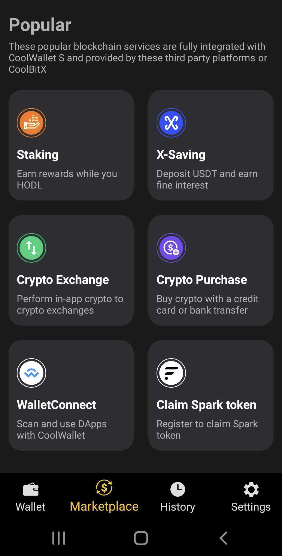
One benefit of being a crypto investor in 2021 is that you don’t need to use centralized exchanges anymore to purchase ETH if you don’t want to.
Our CoolWallet app’s marketplace provides you with several integrated decentralized options to either buy ETH with fiat or swap other coins for it, including other cryptocurrencies, stablecoins and ERC20 tokens.
- To exchange crypto (e.g. BTC) for ETH: use ChangeHero or Changelly
- To purchase ETH with Fiat: Use Banxa or Simplex
- To swap ERC20 tokens: Use WalletConnect to interact with Ethereum DEXs like Uniswap.
Changelly: Also allowing the purchase of BTC with Visa or Mastercard, Changelly allows users an easy-access platform to purchase and convert to ETH. Changelly is integrated with the CoolWallet S, and you can purchase ETH directly from our App with other crypto.
Learn more here on how to purchase crypto on the CoolWallet in-app
9. How Do I Store Ethereum?
First, a word of caution. Cryptocurrency storage and protection is still relatively in its infancy, and since the launch of cryptocurrency exchanges, there have been several notable exchange hacks – resulting in billions lost. You should not be putting money into cryptocurrency which you are not prepared to lose – whether it to market fluctuations, theft, or other circumstances.
You should also
When storing cryptocurrency, it’s highly advised if you keep more than one (1) month’s salary on an exchange or online platform, you invest in cold-storage, which includes:
- Hardware Wallets
- Paper Wallets
- Desktop Wallets
- Online Wallets
Hardware Wallets
Although the most expensive of cold-storage options, hardware wallets also boast the highest degree of security. Think of purchasing and owning cryptocurrency like any other tangible asset, there are certain precautions that need to be taken in order to preserve it – maintenance and security should be at the top of your list.
After all, securing your tokens and coins for a small cost far exceeds the alternative – losing them to an exchange hack.
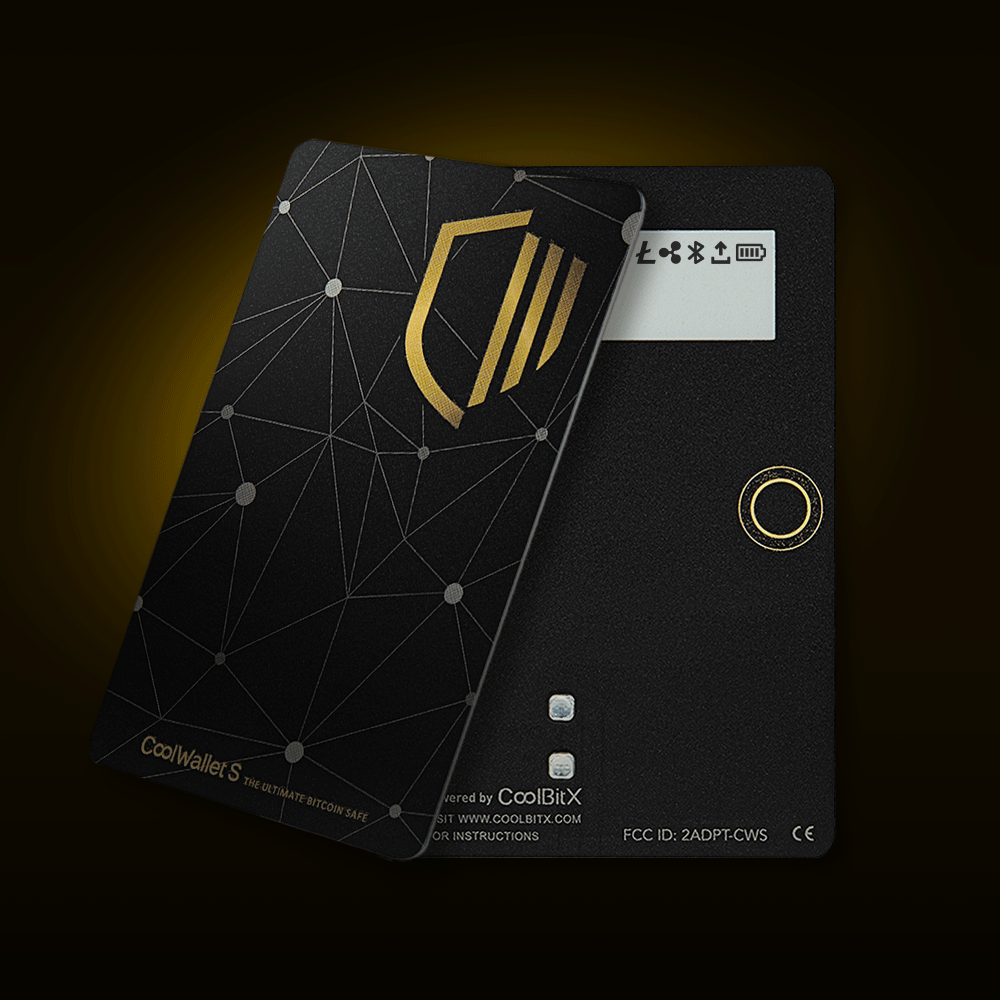
The CoolWallet is your ultimate cryptocurrency safe, allowing you to secure your Ethereum, Bitcoin, Litecoin, Ripple, and Bitcoin Cash, all at your fingertips. CoolWallet S is completely offline, easy to set up, and pairs with your Android 5 (or later) and iPhone 5 (iOS 9.1 or later), and all for a reasonable price of $99. It also supports all ERC20 tokens.
Using the CoolWallet S puts storage back into your hands, and offers you peace of mind that your crypto and investments are safe.
Paper Wallets
True to their name – requiring you to print a private key or QR code on a piece of paper – paper wallets are another effective method of cold storage to store your ETH and other crypto.
Paper wallets offer tangible security for investors, allowing you to keep your ETH (and other cryptos) in your actual grasp, cutting out the need for an intermediary device or service. And, for the cheap (and nearly free) cost of a piece of paper, they are the most economical of all wallet options.
Keep in mind that although you save on cost, you do run the risk of damaging or losing your wallet if not taken care of properly – losing your hard-earned ETH and crypto for good.
Desktop and Online Wallets
Desktop and web-based wallets like Exodus, MyEtherWallet and MetaMask require a malware-free computer in order to store your private key safely on your computer or access it via an Internet browser. In most cases, as long as your computer is free of security weaknesses, then your ETH and crypto will be safe.
However, with rampant phishing and hacking in the online world, its not always easy to be 100% sure you are completely protected, making these software-based wallets the most vulnerable of all.
A word of caution for all these wallets, when sending Ethereum to your wallet, double check the address you are sending it to in order to make sure you are sending to the correct address.
Be very careful of Ethereum phishing attacks that can steal your Ethereum or add your computer to a botnet. Our guide explains more about the safety of desktop wallets.
10. Additional Ethereum Resources
Cryptocurrency is exciting because it stands to (and is in the process of) disrupt traditional financial, social, and political institutions, and supporting its message of decentralization, security, and efficiency is the medium in which it is conveyed.
Unlike the old days, where information was created, controlled, and distributed by only a handful of parties, failing to reach the masses and disguised in hidden agenda, cryptocurrency and blockchain places information and power back in the hands of the user – allowing or non-traditional (and modern) methods of dissemination.
Below are just some of the modern-day resources we recommend you take a look at in order to further acquaint yourself with Ethereum, its founders, community, and message.
- Ethereum White Paper: A formal definition and outline of the Ethereum protocol by founder Vitalik Buterin.
- Ethereum Yellow Paper: A formal definition of the Ethereum protocol written by co-founder Gavin Wood.
- Ethereum’s Website: Ethereum’s official website
- Reddit: The public, anonymous, forum to discuss all things Ethereum and interact with notable members of the community and discuss hot topics.
- GitHub: A web-based hosting system for computer code where Ethereum developers share, discover, and collaborate on projects.
- Etherscan: A block explorer and analytics platform for Ethereum, allowing users to check and search the Ethereum blockchain for transactions, addresses, prices, and tokens.
- Ethereum Twitter: The official Twitter of Ethereum, where code, social, and other updates are posted regularly.
- Vitalik Buterin’s Twitter: Ethereum’s founder’s personal Twitter where he frequently engages with the community and posts about Ethereum’s progress.
- Gavin Wood’s Twitter: Ethereum’s co-founder’s personal Twitter.
- CoinMarketCap: A popular tracking tool and website to monitor cryptocurrency market cap rankings and charts.



